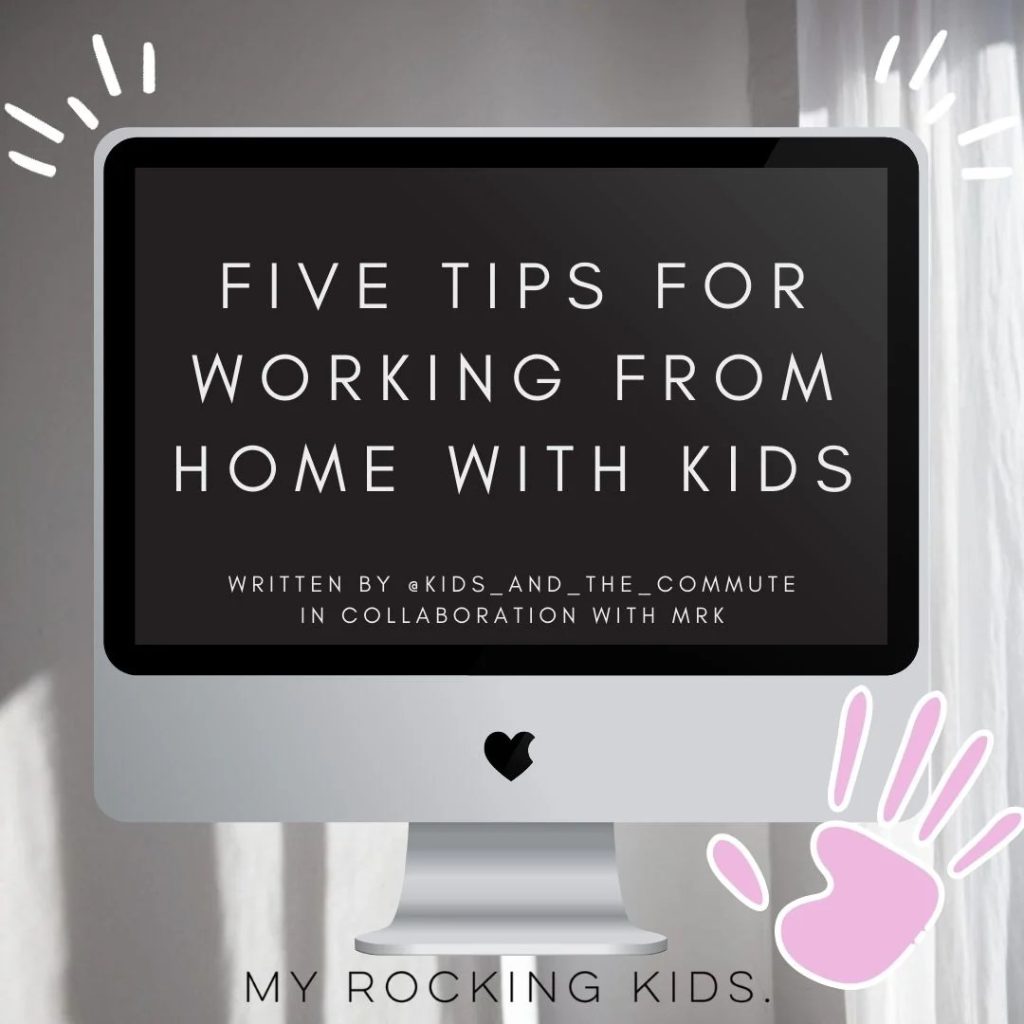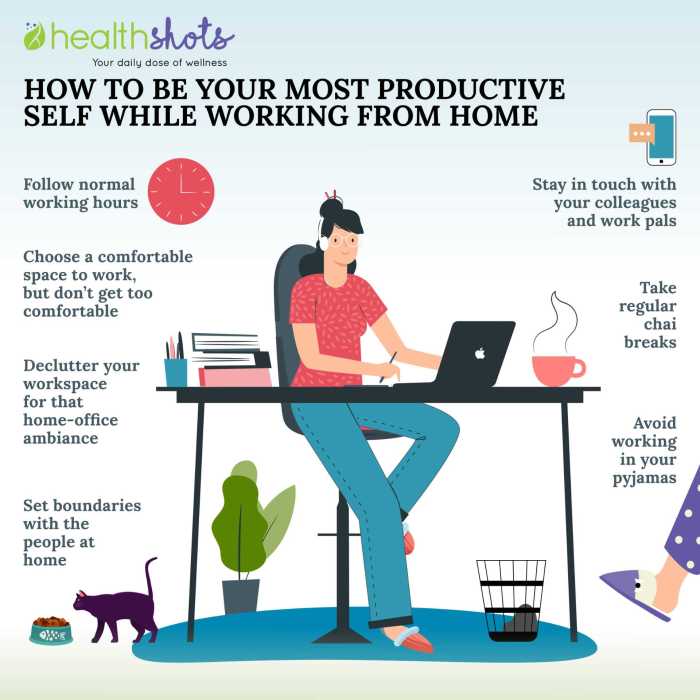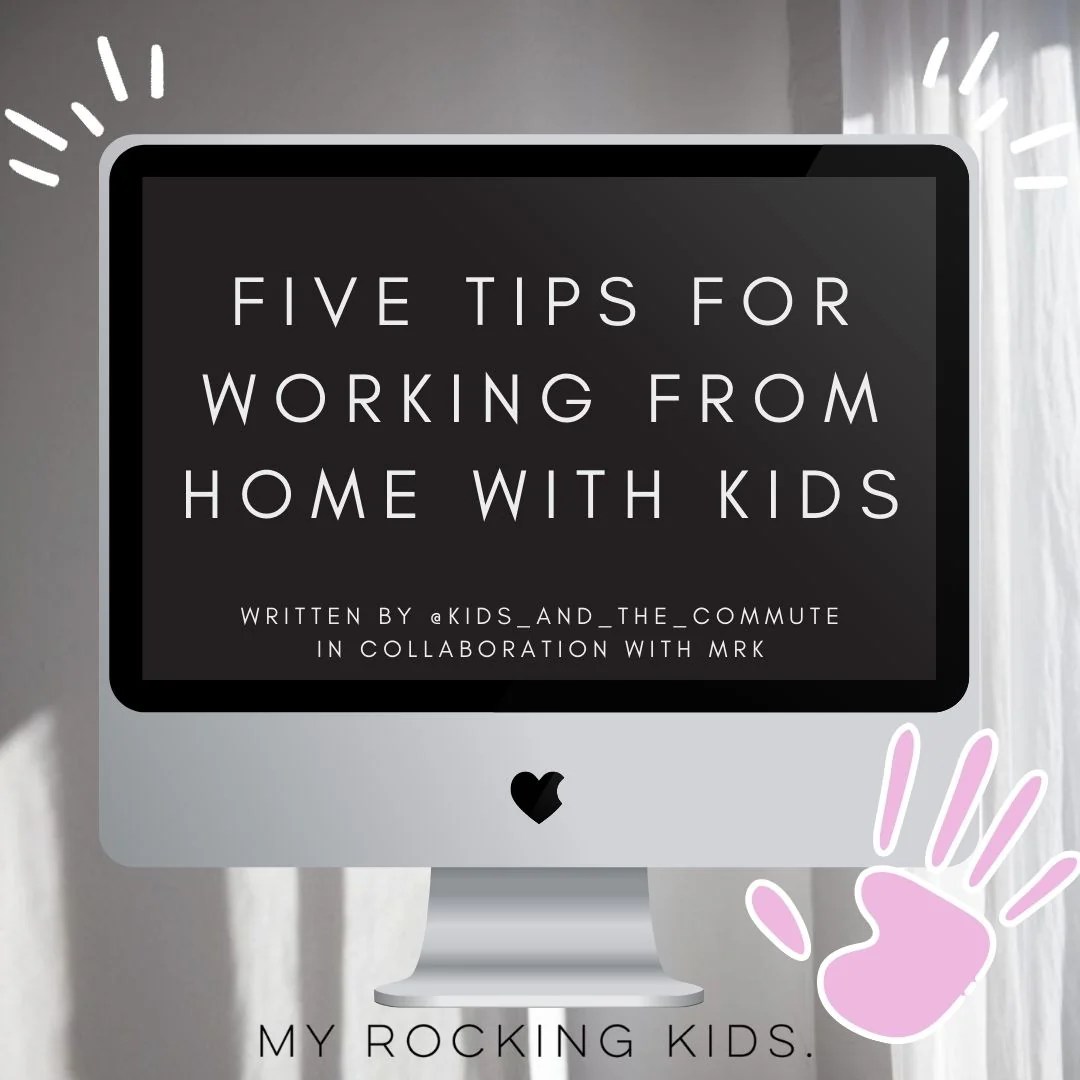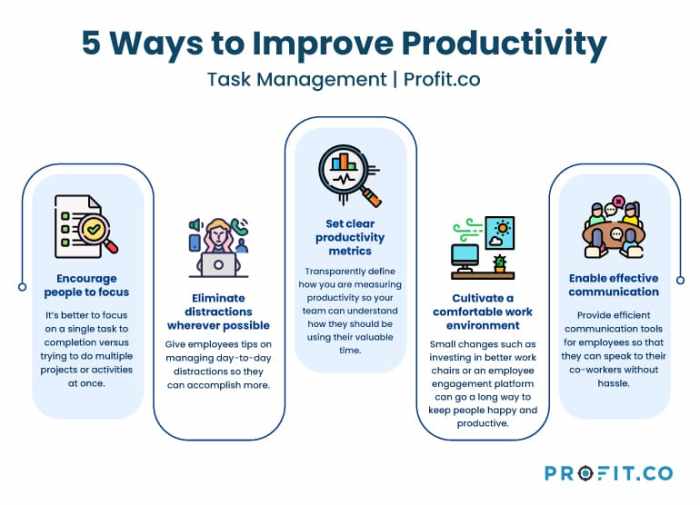
Juggling work and childcare from home can feel like a never-ending balancing act. It’s a common struggle for many parents, especially those navigating the demands of a remote work environment while trying to keep little ones entertained and engaged. But fear not, with a little planning and strategy, you can create a system that allows you to thrive in both roles.
This guide offers practical tips and strategies for maximizing productivity while managing the inevitable chaos of having children around. We’ll delve into creating a dedicated workspace, mastering time management, engaging kids in productive activities, and prioritizing self-care. Together, we’ll explore how to find a rhythm that fosters both your professional success and a happy, thriving home environment.
Setting Up a Productive Home Office
Working from home with kids can be challenging, but having a dedicated workspace can make a big difference in your productivity. A dedicated workspace can help you focus, minimize distractions, and create a clear separation between work and home life.
Designing a Functional Home Office
A functional home office should be designed to support your work needs and promote productivity. Here are some tips for creating a home office that works for you:
- Choose a quiet location: Find a space in your home that is relatively quiet and free from distractions. This might be a spare room, a corner of your living room, or even a dedicated desk in your bedroom. If you can’t find a completely quiet space, consider using noise-canceling headphones or white noise to block out distractions.
- Invest in a comfortable chair: You’ll be spending a lot of time sitting at your desk, so it’s important to invest in a comfortable chair that supports your back and posture. Look for a chair with adjustable height, lumbar support, and armrests.
- Organize your workspace: A cluttered workspace can be distracting and make it harder to focus. Take the time to organize your desk and put everything in its place. This could include using a desk organizer, file folders, or even a simple tray to keep your work area tidy.
- Add some personal touches: Make your home office a space you enjoy being in. Add some personal touches, like a plant, a picture frame, or a small piece of artwork. This can help you feel more relaxed and motivated to work.
Benefits of a Separate Workspace
Having a separate workspace, even if it’s just a designated corner, can have several benefits for your productivity:
- Creates a clear boundary between work and home: When you have a dedicated workspace, it signals to your brain that you’re in “work mode” and should be focused on your tasks. This can help you avoid distractions from your home life and stay productive.
- Improves focus and concentration: A dedicated workspace can help you focus on your work and avoid distractions from your surroundings. This can lead to increased productivity and better quality work.
- Boosts your mood: Having a dedicated workspace can help you feel more organized and in control of your work environment. This can lead to a more positive mood and increased motivation.
Minimizing Distractions in Your Home Office
Distractions are inevitable when you’re working from home, especially with kids around. However, there are things you can do to minimize distractions and stay focused on your work:
- Set boundaries with your family: Let your family know when you’re working and that you need to be undisturbed. You can create a visual cue, like a closed door or a sign on your desk, to indicate that you’re working.
- Use noise-canceling headphones: Noise-canceling headphones can be a great way to block out distractions from your surroundings, such as children playing or household noises.
- Minimize screen time: Too much screen time can be distracting and can make it harder to focus. Take breaks from your computer and phone to give your eyes and brain a rest.
- Take advantage of quiet times: If possible, try to schedule your most important work tasks for times when your kids are asleep or at school. This will give you the opportunity to focus without distractions.
Managing Time Effectively with Kids Around
Working from home with kids can be a juggling act, but with the right strategies, you can effectively manage your time and maintain a productive workflow. The key is to create a structured schedule that balances work and childcare, while also allowing for flexibility and adaptability.
Scheduling Techniques for Work-Life Balance
A well-structured schedule is crucial for managing time effectively when working from home with children. It helps create a predictable routine that provides structure for both you and your kids.
- Create a Daily or Weekly Schedule: Divide your day into work blocks and childcare blocks. Schedule work tasks during times when your children are engaged in activities like playtime or naps. For example, you could allocate mornings for focused work while your kids are at school or in their playroom.
- Incorporate Flexibility: Remember that schedules can change, especially when dealing with young children. Build in flexibility by including buffer time for unexpected events or changes in your child’s routine.
- Communicate with Your Partner or Family Members: If you have a partner or other family members who can help with childcare, communicate your schedule and expectations clearly. This ensures everyone is on the same page and can support each other.
Setting Clear Boundaries Between Work and Family Time
Establishing clear boundaries between work and family time is essential for maintaining a healthy work-life balance. It helps you focus on your work during designated hours and enjoy quality time with your family without feeling overwhelmed.
- Designate a Dedicated Workspace: Having a separate space for work, even if it’s just a corner of a room, helps create a psychological separation between work and family time.
- Set Work Hours: Establish specific work hours and stick to them as much as possible. Let your family know when you’re working and when you’re off duty.
- Communicate with Your Employer: If possible, communicate with your employer about your childcare responsibilities and any potential scheduling conflicts. This can help you manage expectations and avoid unnecessary stress.
Utilizing “Downtime” or Breaks for Focused Work
Even with a well-structured schedule, there will be times when you need to squeeze in work tasks amidst childcare responsibilities. Utilizing “downtime” or breaks effectively can help you stay productive.
- Short Bursts of Focused Work: Take advantage of short breaks or downtime, such as when your child is playing independently, to complete smaller work tasks.
- Prioritize Tasks: Focus on high-priority tasks during these short bursts of work time.
- Utilize Technology: Use productivity tools like timers or apps to help you stay focused and on track during these shorter work sessions.
Engaging Kids in Productive Activities
Working from home with kids can be a balancing act, but it’s possible to create a productive environment for both you and your children. By engaging them in age-appropriate activities that promote learning and engagement, you can keep them entertained and learning while you work.
Creating a Structured Schedule for Kids’ Activities
A structured schedule for kids’ activities can provide a sense of routine and predictability, which is beneficial for both children and parents. A predictable schedule helps children understand what to expect, making them less likely to interrupt your work.
- Set aside specific times for learning activities. This could be a designated “school time” in the morning or afternoon, or it could be incorporated into the day’s routine. For example, a 30-minute block of time dedicated to reading or math games can be a great way to start the day.
- Schedule breaks for play and free time. Children need time to relax and unwind, and this is especially important when they are being asked to engage in structured activities. Incorporate regular breaks into their schedule for playtime, outdoor exploration, or creative pursuits.
- Be flexible and adjust the schedule as needed. While a schedule can be helpful, it’s important to be flexible and adjust it as needed. If your child is having a particularly difficult day, you may need to shorten their learning time or take a longer break.
Seeking Support and Collaboration
Working from home with kids can be incredibly demanding, and it’s crucial to remember that you don’t have to do it all alone. Seeking support from your partner, family members, or friends can make a world of difference in managing your workload and maintaining your sanity.
Sharing Responsibilities
Sharing responsibilities with your partner or other family members is a fundamental aspect of finding balance. This could involve taking turns watching the kids, sharing household chores, or even helping each other with work tasks.
- Create a shared calendar: Use a shared online calendar to coordinate schedules, ensuring everyone is aware of important appointments, meetings, and deadlines.
- Communicate clearly: Openly discuss your needs and expectations with your partner or family members. Let them know what kind of support you need and how they can best help you.
- Be flexible: Life throws curveballs. Be prepared to adjust plans and be flexible with your responsibilities as needed.
Collaborative Work Strategies
Working from home with kids doesn’t have to mean working in isolation. There are several ways to collaborate with colleagues or clients, even when you’re surrounded by little ones.
- Use video conferencing: Platforms like Zoom, Google Meet, or Microsoft Teams allow you to connect with colleagues face-to-face, even if you’re working from home.
- Leverage online collaboration tools: Tools like Google Docs, Dropbox, or Slack facilitate seamless sharing of documents, projects, and ideas with your team, regardless of location.
- Schedule dedicated work time: Communicate with your colleagues about your availability and schedule dedicated time for focused work sessions, minimizing distractions and ensuring productivity.
Benefits of a Support Network
Having a support network can be a lifeline during times of stress. It provides you with a sense of community, emotional support, and practical assistance.
- Reduced stress and anxiety: Knowing you have people you can rely on can significantly alleviate stress and anxiety, allowing you to focus on your work and family.
- Improved mental well-being: Social connection and support are essential for mental well-being. Having people to talk to and lean on can help you navigate the challenges of working from home with kids.
- Increased productivity: When you feel supported, you’re less likely to feel overwhelmed and more likely to be productive. Knowing you have a backup plan can give you peace of mind and boost your confidence.
Prioritizing Self-Care and Well-being
Working from home with kids can be a challenging balancing act, and it’s easy to neglect your own needs in the midst of the chaos. However, prioritizing self-care is crucial for maintaining your mental and physical health, which in turn will boost your productivity and focus.
The Importance of Taking Breaks
Taking breaks throughout the day is essential for preventing burnout and maintaining your focus. When you’re working from home, it’s easy to get caught up in your tasks and forget to step away for a few minutes. However, even short breaks can make a big difference in your energy levels and productivity.
- Get up and move around. Even a few minutes of stretching or walking can help to clear your head and improve your circulation.
- Step away from your computer screen. Give your eyes a rest by looking at something in the distance or closing your eyes for a few minutes.
- Engage in a relaxing activity. Read a book, listen to music, or meditate to help you unwind and de-stress.
The Benefits of Exercise
Regular exercise is essential for both your physical and mental well-being. When you exercise, your body releases endorphins, which have mood-boosting effects. Exercise can also help to reduce stress, improve sleep, and boost your energy levels.
- Find an activity you enjoy. This will make it more likely that you’ll stick with it.
- Schedule time for exercise. Treat it like any other important appointment.
- Start small. If you’re not used to exercising regularly, start with short sessions and gradually increase the duration and intensity.
Maintaining a Healthy Diet
What you eat can have a significant impact on your energy levels, focus, and overall well-being. Eating a healthy diet can help to improve your mood, reduce stress, and increase your productivity.
- Focus on whole, unprocessed foods. Fruits, vegetables, whole grains, and lean protein are all good choices.
- Stay hydrated. Drink plenty of water throughout the day.
- Limit processed foods, sugary drinks, and caffeine. These can lead to energy crashes and mood swings.
Finding Time for Personal Activities and Hobbies
It’s important to make time for activities that you enjoy, even if you’re working from home with kids. These activities can help you to relax, recharge, and maintain your sense of self.
- Schedule time for yourself. Even if it’s just for 30 minutes a day, make time for something you enjoy.
- Be flexible. Sometimes you’ll need to adjust your plans based on your kids’ needs.
- Don’t be afraid to ask for help. If you need a break, ask your partner, a friend, or a family member to watch the kids for a while.
Embracing Flexibility and Adaptability

Working from home with kids can be unpredictable, and the key to success is embracing flexibility and adaptability. This means being prepared to adjust your work schedule, tasks, and even your expectations to accommodate the ever-changing demands of family life.
Adjusting Work Schedules and Tasks
The beauty of working from home is the flexibility it offers. You can adjust your work schedule to accommodate your children’s needs. For example, if your child has a doctor’s appointment during your usual work hours, you can move your work schedule around to make it work. You can also break down large tasks into smaller, more manageable chunks, allowing you to work on them in short bursts throughout the day, fitting in around your child’s activities.
Utilizing Technology to Stay Connected and Productive
Technology can be your best friend when working from home with kids. It can help you stay connected with your colleagues and clients, and it can also help you manage your time and tasks more effectively. For example, you can use video conferencing to attend meetings, email to communicate with colleagues, and project management software to track your progress.
Embracing the Challenges and Opportunities
Working from home with kids can be challenging, but it also offers unique opportunities. For example, you can use your flexibility to spend more time with your children, and you can also use your work experience to teach them valuable life lessons. For example, you can show them how to manage their time effectively, how to work independently, and how to solve problems creatively.
Understanding the Concept of Productivity

Productivity is the measure of efficiency and effectiveness in achieving a specific goal. It’s about making the most of your time and resources to produce valuable outputs. In the context of work, productivity translates to completing tasks efficiently, meeting deadlines, and contributing to the overall success of your team or organization.
Measuring and Tracking Productivity
To understand how productive you are, you need to measure and track your progress. There are various ways to do this, depending on your work and goals.
- Time tracking: This involves recording the time spent on specific tasks. You can use time tracking apps, spreadsheets, or even a simple notebook to track your time.
- Output tracking: This involves measuring the amount of work you complete. For example, if you’re a writer, you could track the number of words you write each day.
- Goal setting: Setting specific, measurable, achievable, relevant, and time-bound (SMART) goals helps you track your progress and measure your productivity against those goals.
Factors Affecting Productivity
Several factors can influence your productivity, including:
- Motivation: Feeling motivated and engaged in your work is crucial for productivity. When you’re motivated, you’re more likely to focus, put in effort, and achieve your goals.
- Focus: The ability to concentrate and eliminate distractions is essential for productivity. When you can focus, you can complete tasks more efficiently and effectively.
- Time management: Effectively managing your time allows you to prioritize tasks, allocate resources, and avoid procrastination. Good time management skills are essential for staying on track and achieving your goals.
- Environment: Your physical and mental environment can significantly impact your productivity. A quiet, organized workspace, adequate lighting, and comfortable seating can all contribute to a productive environment.
- Health and well-being: Taking care of your physical and mental health is essential for maintaining productivity. Getting enough sleep, eating a healthy diet, and exercising regularly can all improve your focus and energy levels.
Tips for Improving Productivity
- Set clear goals: Having specific, measurable, achievable, relevant, and time-bound (SMART) goals gives you direction and helps you track your progress.
- Prioritize tasks: Identify the most important tasks and focus on completing them first.
- Break down large tasks: Divide large tasks into smaller, manageable chunks. This makes them seem less daunting and easier to tackle.
- Minimize distractions: Identify and eliminate distractions that hinder your focus. This might involve turning off notifications, finding a quiet workspace, or using noise-canceling headphones.
- Take breaks: Regular breaks can help you stay refreshed and focused. Short breaks throughout the day can improve your overall productivity.
- Use productivity tools: There are many tools and apps available that can help you manage your time, track your progress, and stay organized.
The journey of working from home with kids is unique and often unpredictable. It’s about embracing flexibility, adapting to change, and finding a balance that works for your family. Remember, you’re not alone in this, and with a little creativity and support, you can successfully navigate the challenges and reap the rewards of this dynamic lifestyle.
FAQ Corner
How do I manage distractions from my kids while working?
Communicate with your children about your work schedule and set clear boundaries. Designate specific times for work and play, and involve them in age-appropriate activities during your work hours.
What if my kids need me constantly?
It’s important to be flexible and adaptable. If your child needs you, take a break and attend to their needs. Communicate with your employer if necessary and explain the situation. You can also explore options like hiring a babysitter or having a family member help out.
How do I stay motivated when working from home with kids?
Set realistic goals and celebrate small wins. Break down larger tasks into smaller, manageable steps. Reward yourself for staying on track and focus on the positive aspects of working from home, like flexibility and spending more time with your family.


